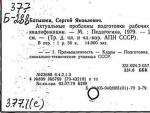Teleportation of queen ant atta. Mysteries of nature: Teleportation of the queen ant
Building entire underground cities. From birth, these ants are deprived of vision, but they belong to the only form of life that, like humans, leads Agriculture.
However, the Attas came up with an incredible telecommunications system that is difficult to comprehend logically. In addition, ants have been found to have a functioning teleportation system. According to scientists, the secrets of teleportation American ants have been used for millions of years. In the course of research of that type, it was concluded that atta possessed two amazing gifts: instantaneous movement and an unknown method over a huge distance.
This was prompted by the observation of blind creatures engaged in growing small mushrooms, constantly faced with the problem of transportation, but able to instantly restore order, assessing the situation with lightning speed.
Teleportation of the termite queen
Unique abilities of the uterus
In the middle of the atta metropolis lives the uterus - a giant female specimen. While still small in size, the young queens scatter for the foundation. Having produced a sufficient number of ants to serve her, she begins to grow to enormous sizes.

To save the uterus, working ants construct a chamber from a material resembling concrete in strength. Being in the middle of the shelter, the queen is almost completely isolated from the world. The chambers are about the size of a coconut and have walls about 3 inches thick, with only a few small passages for the worker ants to service the queen. Each hole has only its own purpose: removal of excrement, delivery of food, egg trough, passage of “midwives”. The approaches are also quite durable, thick-walled. about these ants:
Victor Efimov. Ants Atta: Teleportation
The uterus has a unique feature
She's instantly capable disappear from the bunker when the anthill is threatened. Researchers were able to establish that, disappearing from the main bunker, the uterus in some strange way appears in another, located at a distance of tens of meters from the metropolis.
This is all the more mysterious since the ants do not dig tunnels in advance so that the queen can escape, and backup chambers are not built in advance. It takes just a few minutes for the uterus to move from chamber to chamber. Observing the uterus, scientists concluded that the individual has perfect mastery of the secret of teleportation, which works in emergencies.
During research at the bunker carefully removed the side part and marked the uterus with paint, applying various patterns. The insect is so huge that it occupies the entire area. By leaving the bunker open or covered with glass, you can observe the queen, which often dies from such experiments. But as soon as the camera is completely closed for a minute, the incredible will happen: the huge, clumsy uterus will disappear.
Similar experiments were carried out more than once, but each time the queen literally evaporated from the damaged bunker and appeared in a new one. Some skeptics argued that the found queen was a completely different individual, but the identity of the applied patterns convinced otherwise. The search for additional emergency tunnels and emergency chambers was conducted in vain.
The queen teleports the bunker
Subsequent discoveries During the excavations, even the experienced ones were stunned: at a distance of tens of meters from the destroyed anthill, not only the same queen appeared, but also a completely similar bunker. The complex pattern on the insect and the accidentally smeared inner wall of the chamber during application fully confirmed this. Incredibly, the uterus survived exact copy his bunker, but in a completely intact form, without damage.
It is more expedient to imagine that the atta, having received a certain signal from the uterus, jointly teleport it. This suggests the conclusion that teleportation is an integral part of the life of an atta.
If a person could master teleportation, which has been characteristic of ants for millions of years, we would soon reach the most distant stars!
Atta ants are insects of the American tropics. However, they are also present in warm parts North America several varieties, and one of them even got into the state of New Jersey.
These creatures live in communities in their own underground cities, engaged, like a person, in agriculture and succeeded in this no less, if not more, than a person. But the attas also came up with something else, so incredible that it almost defies our logic. They seem to be able to teleport!
Incredible attas live in multi-million ant megacities, reaching 15 meters in diameter and 6 meters in depth. Life here is extraordinarily complex, and the cities themselves are served by almost the same public utility systems as our megacities. But unlike ours, these systems function flawlessly. The basis of ant farming is the cultivation of small fungi on a substrate of leaves and petals obtained from the outside world. The entire life of the city, and primarily the reproduction of offspring, is connected with these agricultural works.
Reproduction is carried out by one or, at best, several huge queens, each of them several thousand times larger than the largest worker ant. Eggs come from the queens in a continuous stream, and the queens themselves are on a strict diet, which is monitored by nurse ants - this allows you to breed one of several types of adult ants in accordance with the needs of the city. Each queen receives only one type of food and lays the same eggs.

Radial roads with underground passages and canopies that protect from heavy rains, ring roads and even with cloverleaf-type interchanges. On the roads, streams of ants walk out without a burden, and crumbs loaded with pieces of leaves descend towards them. Weighing thousands of these leaves, experts came to the conclusion that their weight is at least twice that of an ant.
Having tied a thin colored thread around one ant, scientists traced its path out of the city. He moved without stopping towards the lonely standing tree, which was about four hundred meters away. Then he climbed up this tree, climbed onto the crown, selected a leaf and began to bite off a piece from it. In the evening, watching the return of an ant loaded with a heavy burden back to its city, scientists witnessed the formation of a real traffic jam.
The twig that the ant was dragging fell onto one of the ant roads. The incoming and outgoing streams of ants mixed over several meters. Suddenly, several larger police ants appeared among them. There was a dump for about two hours, but the ants raked old leaves and all sorts of rubbish aside and built a workaround, along which the workers immediately moved.
The researchers had a question: where did police ants come from so quickly, which under normal conditions disperse many meters from each other?
That same night, scientists conducted an experiment on a 60-meter-long ant road with very heavy traffic. They installed surveillance devices and then blocked the road. A minute later the ant policeman appeared. Having crashed into a crowd of ants, he moved his antennae (atta blind) and forced them to throw leaves on the side of the road.
Other policemen rushed from the city, who acted in the same way, and then began to drive away the unloaded ants from the barrier arranged by the scientists. Meanwhile, the road began to be detoured. Part of the police forces stuck around the barrier in order to direct the approaching ants, who had already dropped their load, into the city, showing them the direction to go around. And so new way paved. The ants were returning for the previously abandoned cargo - strictly along the left side of the road. They did not interfere with the oncoming traffic of workers returning with cargo along the new road to the city.
This opposition to the ants marching into the city again made scientists wonder: how did the ants know what to do, did the police tell them about it or not? Scientists decided that information about an unexpected obstacle on the road was transmitted to the anthill through sequential contact with antennas. However, the question arose: is it possible to transmit information at such a speed using antenna contact? An analysis was carried out, and here are the results: even if 60 thousand ants simultaneously turned in one direction and instantly touched each other with their antennas, the signal would be transmitted a hundred times slower than the speed at which the police arrived! Therefore, the atta has a telecommunication system, and not mechanical, not through touch.
This is not a video system - after all, the police are underground, and the police have no eyes. Smell is also highly unlikely (although it is now believed that odors are electromagnetic in nature).
Nevertheless, attas can transmit information over distances of approximately three to five kilometers, and its transmission occurs at a speed many times greater than any possible mechanical action.
There are several hypotheses on this score: electromagnetic, telepathic, acoustic.
If the secret is in acoustics, then either the police ants in the depths of cities are endowed with some kind of supersensitive receiving organs sound signals, or the information is transmitted by some special ants. Could these be police patrol ants? Hardly, at least not until the police arrive at the scene where something is happening.
Dr. H. Forrest discovered that ants different types They make sounds by clicking their paw joints, rubbing their paws and closing their jaws. She also became convinced that ants are capable of producing much more complex sounds using so-called chirping organs, reminiscent of those found in grasshoppers and locusts. Dr. Forrest believes that the sounds that arise can easily be heard by a person with keen hearing who is close to the insects. As proof, she presented tape recordings of the sounds of twenty-five species of ants.
Maybe this explains everything? No, most likely the last word hasn't been said yet.
Assuming an acoustic connection, we will be forced to assume that the sounds made by ants must constitute a language through which information is transmitted. Any police officer can send a signal. Someone needs to determine its origin and take appropriate action. What language is this? Unknown...
An even more incredible observation regarding atta still defies explanation. This is teleportation. This term is widely used among parapsychologists and mystics. Initially, the term meant the instantaneous transfer of objects from one point to another, even through a solid medium (abbreviated MP).
Until recently, serious science, if not ignored the very idea of the possibility of teleportation, treated it with fear.
IN last years The orthodox people, especially nuclear physicists, who allow tunnel transitions of microparticles, began to talk about this in a low voice. However, there are reports of large-scale MPs occurring both in nature and in laboratories.
The fact that instantaneous transfers exist would revolutionize all technology. But our lives would change so much that we might regret it and impose strict restrictions on them.
Perhaps teleportation is what helps atta.
Atta queens only eat and reproduce. While still small, they fly away from their hometown, copulate, descend to the ground, dig into it and found new town. When the queen gives birth to a galaxy of worker ants, they begin to care for her, and in the meantime she grows to monstrous sizes and increases the productivity of her egg conveyor.
To protect the queen, worker ants build a chamber so strong that it can only be destroyed with a heavy crowbar. The chamber completely surrounds the uterus, and only in its lowermost part there are a number of small holes for the entry and exit of food carriers, channels for the removal of excrement and the passage of midwives who look after the eggs, as well as a trough for the eggs.
Often these chambers reach the size coconut, they are slightly flattened and slightly elongated, and the thickness of the walls can be several centimeters. If you get to this chamber and carefully cut off the side of it, you can mark the uterus with a thin stream of paint from a spray bottle (this large insect occupies the entire chamber).
As long as the camera remains open or covered with a piece of glass, nothing happens. In such cases, the queen often dies, or the worker ants move her to another place. Sometimes she continues to lay eggs, although she is colored. However, if you close the chamber tightly for just a few minutes, the uterus will disappear!
Without a trace!
This fact could be explained by the fact that the ants kill the queen and then remove her remains through the lower small holes. But don't forget about the paint! There was no trace of her.
Further excavations and searches in the same anthill, sometimes lasting several hours, stunned all participants in the experiment: a few tens of meters from the place where the queen disappeared there was another heavy-duty concrete chamber, in which there was that same queen with all identification marks in the form of spots of paint - she felt great, ate food and laid eggs! And this was observed time after time.
Isn't this MP? And if not, then tell me how this happens? They want to convince us that the atta removes a concrete chamber 30 cm long, digs a tunnel with a diameter of 8 to 10 cm and a length of about several meters, digs another cavity 60 cm long, pushes the uterus into it and then builds it around it new camera- and all this in a few hours. This assumption does not stand up to criticism, since all reports say: the uterus disappears from such chambers within a few minutes - and the chamber does not even collapse.
Wouldn't it be more reasonable to propose a teleportation system for the most important members of ant society?
From the point of view of some experts, there is something unpleasant about all this. Such things clearly contradict everything we have been taught, what we are used to seeing and what we like. But is this really more annoying than electricity, which, being connected to one end of a metal wire, performs at the other end useful work? After all, until very recently, no one had a clear theory of what electricity was.
Sound passes through matter, light passes through matter, so why can't matter pass through matter? In any case, matter is 99 percent made of holes, and it is probably possible to leak through it in the same way that any of us can pierce a metal mesh with a stream of water.
If we manage to accept the principles of MP, exit to deep space and even other galaxies may turn out to be extremely simple - perhaps it will all come down to just leaking through space!
Kirill Butusov
These ants have attracted the attention of the whole world not only because they build the largest anthills, but also because their queens are capable of so-called teleportation. Honestly, I don’t know how true the last assumption is. Let's try to figure it out.

But first a little general information. The genus Atta includes 15 species, and all of them are distributed in the territory from the southern regions of North America and almost throughout South America(from Texas to Argentina). For themselves, they build anthills, which are considered the largest in the world. Their diameter can reach 10 meters, and they go 6-7 meters deep. In this insect “metropolis” live from 5 to 8 million ants and only one queen, but what a queen.


Atta ants, like many others, have divisions into peculiar castes: worker ants (gardeners, fungus growers, builders, foragers), soldiers and the queen. The dimensions of the former range from 3 to 20 mm, the latter – from 22 to 24 mm. The uterus reaches simply enormous sizes. Its weight is almost 700 times the weight of the average working ant.
 On the left is a worker ant, on the right is a soldier
On the left is a worker ant, on the right is a soldier 
The main thing that these leaf-cutter ants are famous for is their “agriculture”. In anthills in special “greenhouses” they grow Basidiomycota mushrooms, the nutrient medium for which is the chewed mass of leaves. To create it, they cut off the leaves of many types of plants, including agricultural and ornamental ones, which causes significant damage to agriculture.
 Leaf-cutter ants work
Leaf-cutter ants work 
Well, now about the most interesting and unusual thing - about the uterus and its ability to teleport. It all starts with the fact that one young queen separates from her parental home and sets off on a free flight. During this careless and free life she mates only once, after which she “descends” to the ground and lays eggs in it, from which the first worker ants emerge. Their main purpose is to care for the uterus.

 Sheet cutting
Sheet cutting Over time, it grows to gigantic size and continues to produce eggs like a conveyor belt. The anthill is also growing. And after some time, to protect the queen, the worker ants create a special chamber around her, approximately the size of a large coconut and with thick, durable walls. For communication with the outside world, only a few small holes remain: for the entry and exit of worker nurse ants and those that feed and care for the queen. It is impossible to get out of this chamber. The uterus is immured in it for life.


The researchers decided to conduct one experiment. They carefully cut off part of the side wall of the chamber and marked the uterus with a special mark. When they left the camera open or covered it with glass, nothing happened. Sometimes the worker ants had great difficulty moving their queen to another place, or she continued to lay eggs. But as soon as they put the cut out piece back and put the camera in place, in no more than 10-15 minutes the female disappeared from there. Initially it was assumed that the ants removed this piece and moved the female to a new place, or killed her and then carried her out piece by piece. In fact, this would be quite possible if not for one BUT.


After some time, scientists began to look for where the huge uterus could have gone, and the result of the search amazed them every time. About a few tens of meters from her original location, another completely closed chamber was discovered. At first they thought that another uterus was “walled up” in it, but when they opened it, their ward was quietly sitting there, with a mark on it. And this phenomenon happened every time. How she can disappear from her cell in a few minutes and end up in a new one still remains a mystery to many scientists.
P.S. Can Queen Atta Ants really teleport, or is this experiment just a hoax?
The atta ant is one of the most mysterious creatures on the planet, causing scientists to rack their brains, to be surprised, delighted, and perplexed. The family lives deep underground, creating numerous megacities. The city is ruled by a queen, placed by her relatives in a bunker whose density resembles concrete.
Insects are blind from birth, but this does not prevent them from actively communicating, working together, keeping the anthill clean, and creating relationships.
Housing
The female atta gives rise to a new family that lives for about 20 years. It itself is placed in a special bunker with thick, durable walls, reaching the size of a coconut. There are several small holes, each performing its own role - removing excrement, supplying food, removing eggs, entering midwives.
She finds herself completely isolated from society. Her main role is the reproduction of offspring, which she has been doing all her life - about 20 years. Several females can live - one main one, a couple of young ones.
The housing of the remaining atta ants is numerous passages, exits, chambers, warehouses, burial grounds and much more. All this is located at a depth of 6 m with a diameter of 15 m.
Amazing creatures
Makes scientists excited about the ability of the queen and all the atta ants to teleport to dangerous situations. This is the main topic of controversy and disagreement among scientists.
When the bunker is damaged, the queen atta ant inexplicably leaves and finds herself at a distance of several tens of meters from her former home. The female is capable of transmitting signals to relatives over a long distance - 5 km, and restoring a bunker similar to the previous structure.
Interesting!
Experiments have been carried out repeatedly in an attempt to explain the instantaneous movement of the atta uterus. The bunker was damaged and a unique pattern was applied to the back of the uterus. After some time, the insect was found several meters away. A more surprising experiment was carried out in laboratory conditions. Bunker conditions were created and covered with a glass lid with several holes. The ant remained in place. As soon as the glass was completely closed, threatening the life of the insect, the queen inexplicably disappeared.
Experiments were conducted in which obstacles were placed in the path of ants that were returning with prey through the studied area. When difficulties arose, a group of “police” ants appeared out of nowhere and cleared the road.
Appearance
And although they are not atta, they build the largest anthills in the world and differ from the rest in their lack of vision. There are about 15 species of atta ants in the world. They live in countries tropical climate, common in America.

Atta ants are no different in structure from other species. But it concerns the uterus itself. The body size is much larger than its relatives, its weight exceeds 700 times. The reddish creatures resemble ours, but there are spikes all over the body in the upper part. A photo of the representative can be seen below.
Reproduction
The young one leaves the family and takes to the air in search of a male. lasts several weeks. After this, the young male dies, the female finds a favorable place, burrows deep into the ground, and lays eggs.
The first larvae are always worker ants. They begin to build an anthill. Over time, the uterus reaches unrealistic sizes, increasing the number of eggs reproduced. Once fertilized, she gives life to new offspring for the entire period - about 20 years.
Nutrition
Atta ants have become famous for farming. In special greenhouses they grow Basidiomycota mushrooms. A favorable environment for them is created from chewed leaves. The resulting mass after interaction with fungi is food for adult ants and larvae.
Ants cut leaves with powerful sharp jaws. They carry whole plates into the anthill and engage in chewing joint forces than they remind. A large number of insects cause significant harm to agriculture and wildlife.
Ants are so atta interesting creatures that they are kept even at home, and they pay a lot of money for the purchase.
“...If a person could master the knowledge that tiny ants have possessed for millions of years, within a few years we would have reached the farthest stars!...”
Frankly, I myself have never been interested in insects. But recently I came across Ivan Sanderson’s book “Beasts” and, having read up to the fifteenth chapter and the atta ants, I realized that I had no strength to remain silent about it. So, meet: paranormal atta ants from North America.
What kind of ants are these?
The ants that created this system are called attia, a tribe of the myrmecological group of insects in the family Formicidae, or ants. Among the attia, the most famous is the atta species - like most of its relatives, it is an insect of the American tropics. However, the tribe is represented in warm parts North America with several varieties, and one of them even reached New Jersey. These creatures live in communities in their cities, which are located underground.
This is the only known form of life on Earth that, like humans, is engaged in agriculture, and they did not succeed in this less than a person, if not more. But the Attas also came up with something else, in which they are head and shoulders above us, this “something” is so incredible that it almost defies our logic. In short, this is definitely a telecommunications system, and perhaps a fully developed, working teleportation system.
Atta civilization is based on agriculture. It consists of growing certain small fungi, which are planted in nurseries from leaves and petal trimmings. Ants collect leaves and flowers from outside and bring them to cities. These cities can reach 16 meters in diameter and 7 meters in depth. The life of the city, and, first of all, the reproduction of the population, is connected with these agricultural works.
Atta has to go up and collect leaf scraps. Radiating from the anthill are radial roads with underground passages, canopies protecting from heavy rains, ring roads and even with interchanges like “ maple leaf" Streams of ants scurry along the roads - empty ones go out, and crumbs loaded with pieces of leaves descend towards them, reminiscent of huge sails on miniature boats. By weighing thousands of these leaves, experts concluded that their weight is at least twice that of an ant. At least in the species we studied.

Now let's get to the fun part.
Atta queens are giant females that only eat and reproduce. While still small in size, they fly away from their hometown, copulate, descend to the ground, dig into it and found a new city. When the queen has given birth to a galaxy of worker ants, they begin to care for her, and in the meantime she grows to monstrous sizes and increases the productivity of her “conveyor” of eggs. To protect the queen, worker ants build a concrete chamber that is so strong that it can only be destroyed with a heavy crowbar. The chamber completely surrounds the uterus, and only in its very lower part there are a number of small holes for the entry and exit of food carriers, channels for the removal of excrement and the passage of “midwives” monitoring the eggs, as well as a trench for the eggs. These chambers are often about the size of a coconut, although they are slightly flattened and slightly elongated, and the walls may be three inches thick. The approaches to these cameras in some cities are also concrete.
If you get to the chamber in which the queen is located and carefully cut off the side of it, you will see that the entire chamber is occupied by a large insect, which can be marked with a thin stream of paint from a spray bottle.
As long as the camera remains open or covered with a piece of glass, nothing happens. In such cases, the queen often dies or the worker ants transfer her to another place. Sometimes she just continues to lay eggs, albeit colored. However, if you close the camera for just a few minutes, something will happen. The uterus will disappear.
This could be explained - and was previously thought - by the fact that the ants kill her and then remove the remains. But do not forget about the paint, which in some cases was applied in the form of a very bizarre pattern.
Further excavations and searches in the same city, sometimes lasting several hours, stunned all participants: a few tens of meters from the place where the uterus disappeared there was another heavy-duty concrete chamber, in which was the same uterus with all the “identification marks” - it is magnificent felt herself, ate food and laid eggs! This has been observed time after time.
Is this instantaneous movement? And if not, how does this happen? Atta remove a foot long concrete chamber, dig a tunnel three to four inches in diameter and several yards long, dig another two foot long cavity, push the queen into it and then build a new concrete chamber around it? It is impossible to imagine that atta ants in a short time - no more than an hour, even several hours (while the experimenters are searching for the second chamber) - time manage to dig a tunnel several tens of meters long, build a new “concrete chamber” and drag the queen there.
The mystery of the atta ants has not yet been satisfactorily explained. So far there is no acceptable evidence of the phenomenon of teleportation and no one has yet proven that teleportation experiments can be reproduced - and this is precisely the basis scientific proof any phenomenon. However, in recent years they have begun to talk about teleportation in a low voice in the scientific world, primarily among nuclear physicists, and then only in connection with infinitesimal particles of matter, which can be considered as immaterial and therefore not a barrier to the instantaneous movement of an equally microscopic scale.








 Why do you dream of being a beggar?
Why do you dream of being a beggar? Read the book “Pastel Magic” online Read Pastel Magic
Read the book “Pastel Magic” online Read Pastel Magic Prophet's Church on Porokhov
Prophet's Church on Porokhov Toasts with garlic from black bread: recipe
Toasts with garlic from black bread: recipe